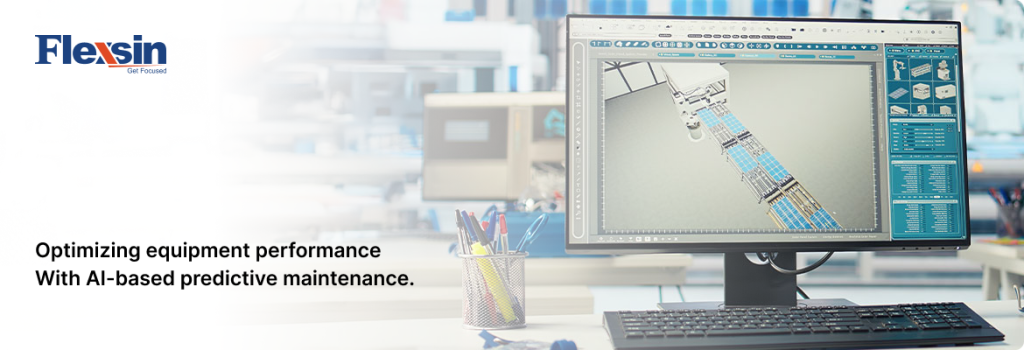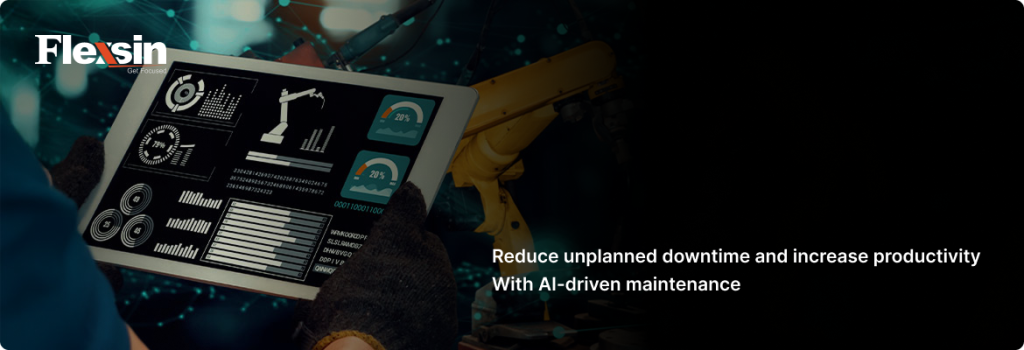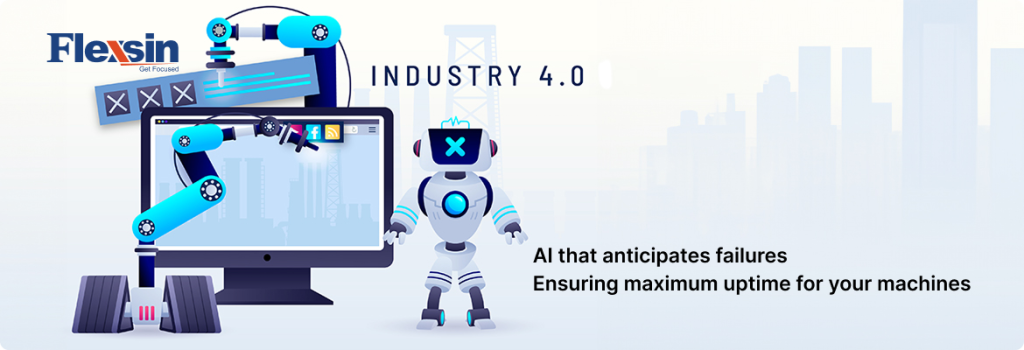Unplanned downtime costs manufacturers an estimated $50 billion annually, but what if AI could predict failures before they happen? AI-powered predictive maintenance (PdM) is transforming industrial operations, helping businesses cut maintenance costs by 20–30%, extend equipment lifespan by 40%, and boost Overall Equipment Effectiveness (OEE) by 15–25%. Yet, many companies struggle with implementation due to integration challenges, data silos, and scalability issues.
This is where AI predictive maintenance consulting services come in. By leveraging machine learning, IoT sensors, and real-time analytics, experts like Flexsin Technologies help businesses transition from reactive to predictive maintenance, turning downtime into dollar savings.
Let’s explore how AI-driven PdM delivers seven-figure cost reductions and why 2025 is the year to invest.
1. How AI Predictive Maintenance Consulting Maximizes ROI
Most factories still rely on reactive maintenance (fixing failures after they occur) that high downtime costs, and preventive maintenance (scheduled checks) that results in wasted labor & parts.
AI predictive maintenance consulting services eliminate guesswork by:
- Analyzing sensor data (vibration, temperature, pressure) to detect anomalies.
- Predicting failures 3–6 months in advance (McKinsey).
- Reducing spare parts inventory waste by 25% (Oracle).
Case Study:
A Fortune 500 manufacturer reduced unplanned downtime by 45% after implementing AI-powered PdM with Flexsin, saving $2.8M annually.
AI-Powered Maintenance Scheduling: Optimizing Labor & Resources
Poor scheduling leads to overtime costs (emergency repairs) and underutilized technicians (preventive maintenance overkill). Flexsin Technology’s AI predictive and adaptive maintenance consulting solves this with:
- Dynamic maintenance scheduling – Prioritizing high-risk equipment.
- Skill-based task allocation – Matching technicians to the right jobs.
- OEE tracking – Measuring true machine productivity.
Example:
A chemical plant used AI to reduce maintenance labor costs by 18% while increasing uptime by 12%.
Predictive Analytics vs. Run-to-Failure: The Cost Difference
- Approach Cost Impact: Downtime Risk
- Run-to-Failure High (emergency repairs): Critical
- Preventive Moderate (unnecessary checks): Medium
- AI Predictive Low (targeted fixes): Minimal
2. How AI Eliminates Unplanned Downtime (And Saves Millions)
Unplanned downtime costs industrial manufacturers $260,000 per hour on average. AI predictive maintenance doesn’t just reduce these costs – it transforms maintenance from a cost center to a profit driver.
Real-Time Failure Prediction: Catching Problems Before They Crash Production
Traditional methods miss early bearing wear signs, subtle motor efficiency drops, and gradual pressure system degradation.
AI predictive and adaptive maintenance solves this with:
- Vibration pattern analysis detecting anomalies 60-90 days before failure.
- Thermal imaging algorithms spotting electrical issues invisible to humans.
- Fluid analysis ML models predicting lubrication breakdowns.

Case Example:
A semiconductor fab reduced unscheduled downtime by 72% after implementing an AI vibration monitoring system, saving $4.3M annually in lost production.
Prescriptive Maintenance: Beyond Predictions to Automated Solutions
Predictive tells you when failure will occur – prescriptive tells you what to do:
- Self-adjusting maintenance schedules based on real-time data.
- Automated work order generation with repair instructions.
- Spare parts inventory optimization using failure probability algorithms.
Digital Twin Technology: Simulating Every Failure Scenario
Digital twins create virtual replicas of physical assets to:
Test maintenance strategies risk-free
Predict how equipment degrades under different conditions
Train AI models with synthetic failure data
3. AI Predictive and Adaptive Growth Strategies
While predictive maintenance reacts to data, adaptive maintenance (AM) continuously learns and improves:
Self-modifying algorithms that adjust to new failure patterns
Automated recalibration of sensor thresholds
Dynamic risk scoring of equipment
Future-Proofing Your Maintenance Strategy
2025-26 will bring:
AI-powered maintenance chatbots for instant troubleshooting
Blockchain-secured maintenance records for compliance
AR-assisted repairs with AI-guided instructions
The data is clear: Companies adopting AI predictive maintenance are outperforming competitors by 19% in OEE and reducing maintenance costs by 7-figures annually.
Flexsin’s AI Predictive Maintenance Consulting Services deliver:
Customized failure prediction models
Seamless integration with your CMMS
Measurable ROI guarantees
4. The Hidden Costs of Traditional Maintenance (And How AI Eliminates Them)
Most financial models only account for direct downtime costs, but the true impact is far greater when you factor in:
The Ripple Effect of Equipment Failure
Secondary damage costs:
A failed bearing can destroy an entire motor assembly (adding 300% to repair costs)
Quality control impacts:
62% of product defects originate from equipment operating outside optimal parameters
Regulatory penalties:
OSHA fines for safety incidents caused by equipment failure average $124K per violation
AI Prevention:
Machine learning models correlate vibration patterns with eventual quality defects, triggering maintenance before defective production occurs.
Workforce Productivity Losses
Emergency repair scenarios require 3.2x more labor hours than planned maintenance.
Skill attrition:
28% of maintenance technicians report burnout from constant “firefighting” mode.
Training gaps:
New hires take 17 months to develop equivalent troubleshooting skills.
AI Solution:
Augmented reality work instructions reduce new technician ramp time by 60% while preserving institutional knowledge.

Energy Waste from Suboptimal Performance
- Degraded equipment consumes 12-18% more energy before complete failure.
- Compressed air leaks from worn seals waste $25K annually in typical plants.
- Undetected motor misalignment increases power consumption by 15%.
Case Example:
A textile mill reduced energy costs by $320K/year after AI identified 47 hidden inefficiencies in its HVAC systems.
5. Implementation Roadmap: How to Deploy AI Predictive Maintenance Successfully
The 90-Day Pilot Framework
Phase 1 (Weeks 1-4):
- Install wireless vibration sensors on 3 critical assets
- Establish baseline performance metrics
- Train superusers on dashboard interpretation
Phase 2 (Weeks 5-8):
- Validate AI alert accuracy against historical failures
- Refine maintenance workflows
- Calculate preliminary ROI
Phase 3 (Weeks 9-12):
Scale to 15 additional machines
Integrate with CMMS
Finalize full deployment plan
Data Readiness Assessment
*Score your facility (1-5 scale):*
- Sensor coverage (Are all critical assets monitored?)
- Data granularity (Is sampling frequency sufficient?)
- System integration (Can data flow to analytics platforms?)
- Labeled failure history (Do past incidents have timestamps?)
Pro Tip:
Facilities scoring <15/20 need foundational work before AI deployment.
Change Management Strategies
Maintenance team incentives:
Bonus for prevented failures vs. repaired failures.
Leadership KPIs:
Track “Avoided Downtime Hours” alongside traditional metrics.
Phased rollout:
Start with non-critical equipment to build confidence.
Resistance-Busting Tactic:
Have AI predict a known upcoming failure during the demo phase to prove effectiveness.
5. Industry-Specific AI Maintenance Applications
CNC machines:
Tool wear prediction improves tolerances by 0.02mm.
Injection molding:
Clamp force monitoring reduces scrap rate by 19%.
Packaging lines:
Vision AI detects conveyor belt wear patterns.
Energy Sector Innovations
Wind turbines:
Blade erosion models optimize maintenance routes.
Substation equipment:
Partial discharge detection prevents catastrophic failures.
Pipeline monitoring:
Acoustic sensors pinpoint corrosion hotspots.
Transportation & Logistics
Fleet maintenance:
Engine ECM data predicts transmission failures.
Railway switches:
Vibration analysis prevents derailments.
Port cranes:
Wire rope degradation monitoring.
Traditional reactive and preventive maintenance methods are no longer sufficient, they lead to unnecessary costs, wasted resources, and production disruptions. AI-powered predictive maintenance revolutionizes this approach by analyzing real-time sensor data, machine learning patterns, and historical trends to forecast failures before they occur, reducing downtime by up to 50%.
Meanwhile, adaptive maintenance takes it further by continuously learning from new data, optimizing maintenance schedules dynamically, and improving accuracy over time. Together, these AI-driven strategies cut costs, extend equipment lifespan, and boost operational efficiency, making them essential for industries aiming for zero unplanned downtime and maximum productivity. Companies that fail to adopt these technologies risk falling behind competitors who leverage AI to transform maintenance into a profit-driving function.

Why Now?
The average ROI timeline for AI predictive maintenance has shrunk from 18 months to <6 months due to:
- 60% reduction in sensor costs since 2020
- Pre-trained industry-specific AI models
- Cloud-based analytics eliminating IT overhead
Flexsin’s Rapid Deployment Package Includes:
- Customized OEE improvement forecast
- Facility-specific cost reduction analysis
- Cybersecurity compliance audit
- Pilot program roadmap
- ROI projection report
By leveraging AI to predict equipment failures, optimize maintenance schedules and slash downtime costs, manufacturing leaders like Jamis Bikes, Sadirat, FPI Future Pipe Industries, Daikin, and many more, have been able to realize game changing results from their industrial manufacturing processes.
Book your free AI predictive and adaptive maintenance consultation with Flexsin Technologies today, and start your journey to save millions in unplanned maintenance and sudden breakdowns.


 Munesh Singh
Munesh Singh